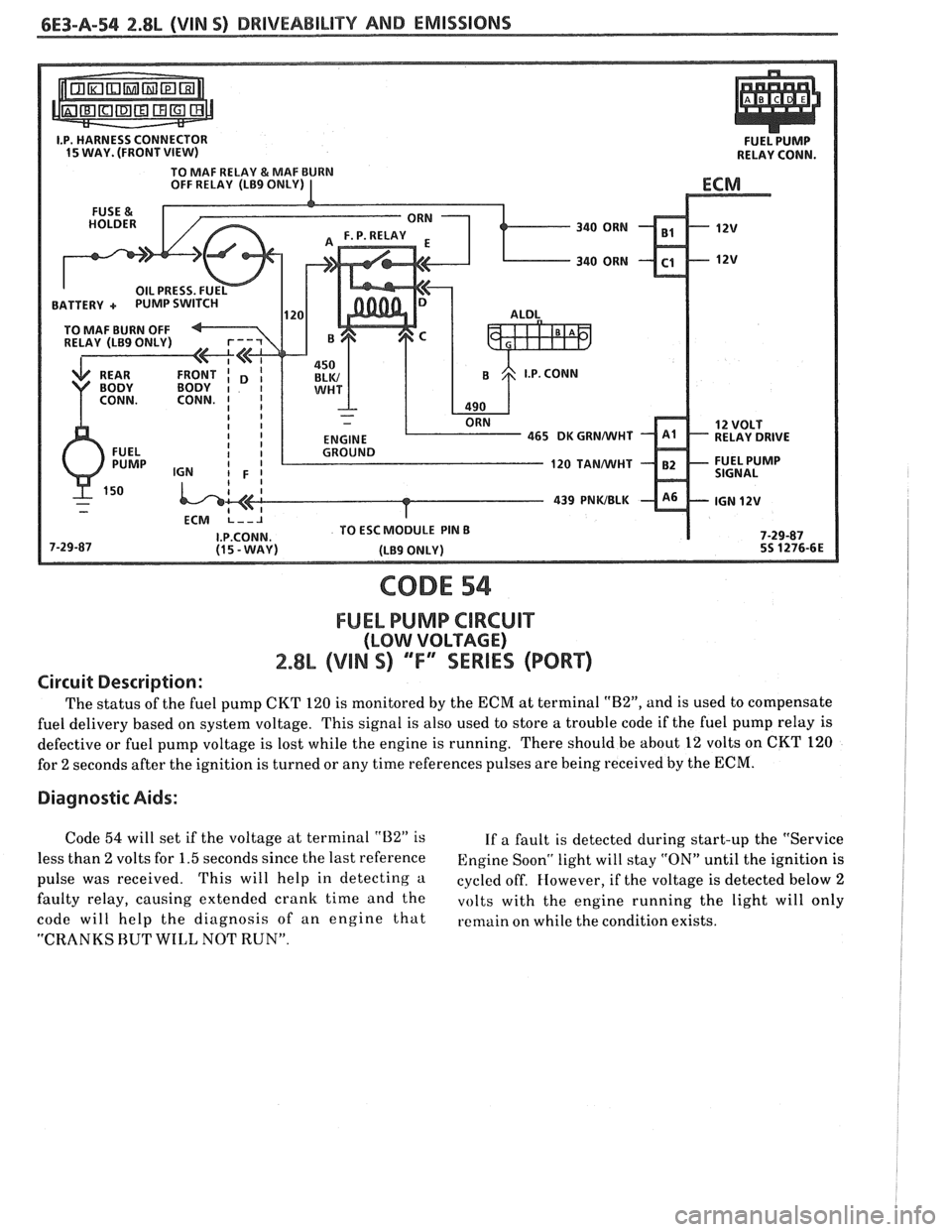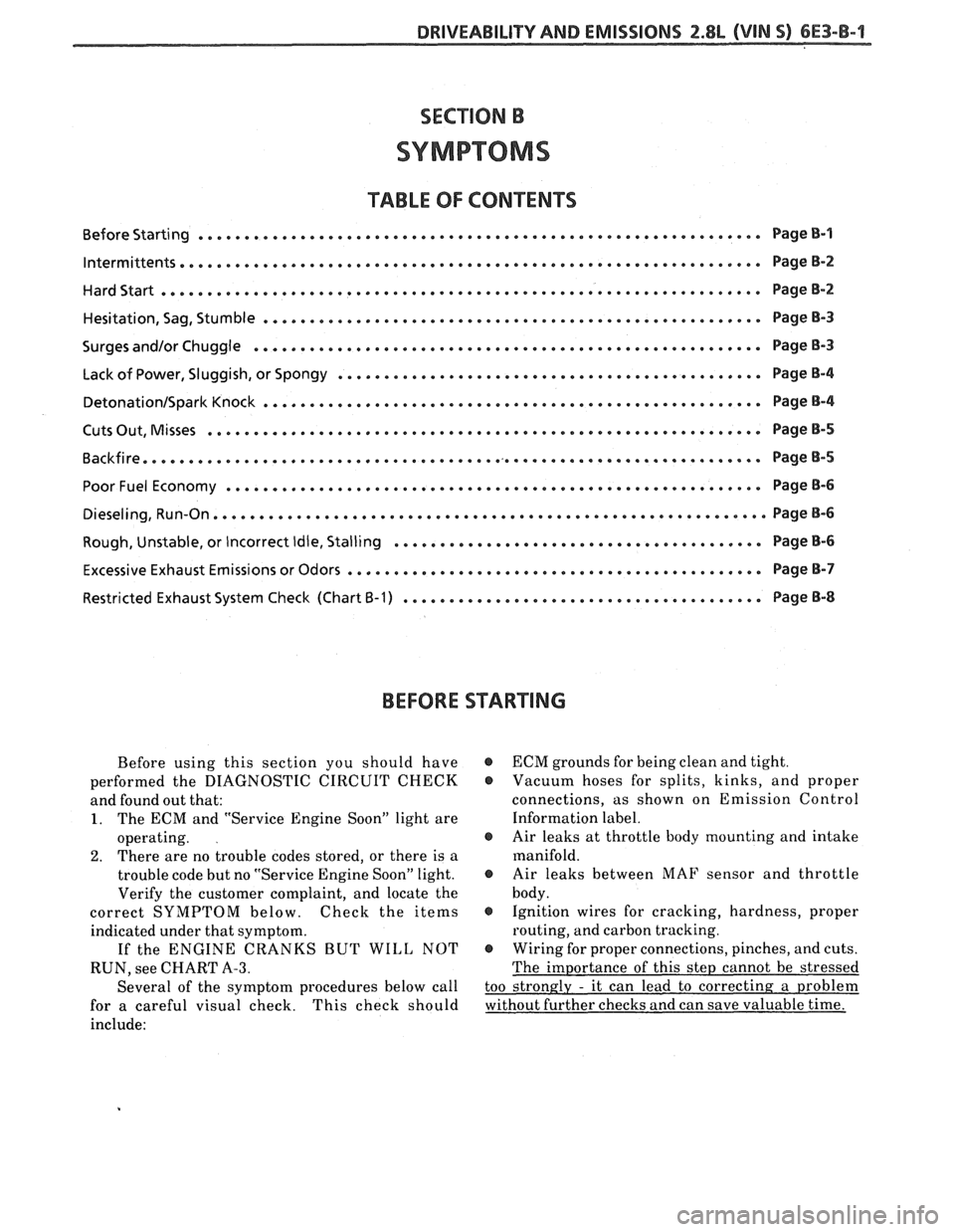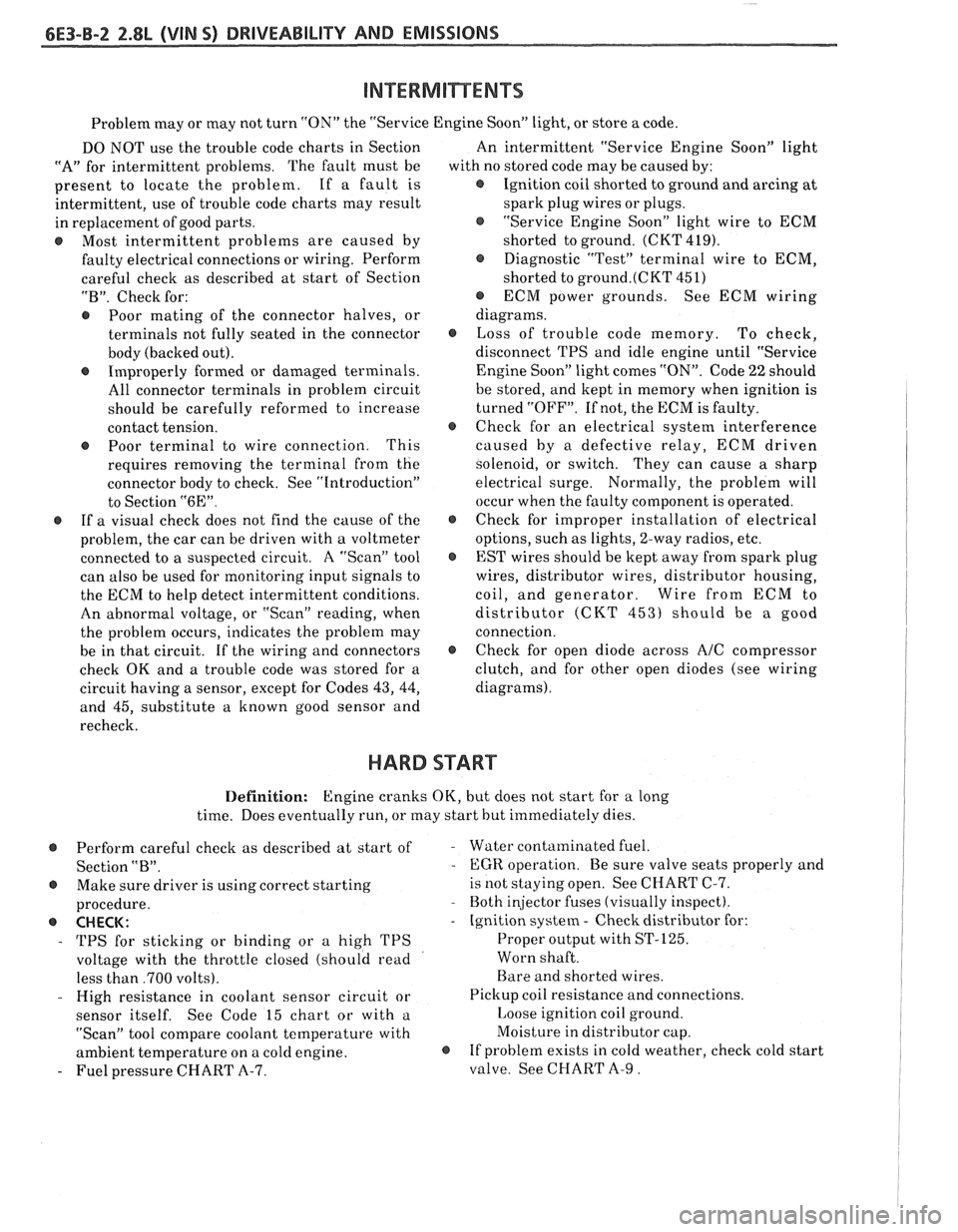Page 698 of 1825
DRIVEABILITY AND EMISSIONS 2.8L (VIN S) 6E3-A-45
START AND IDLE ENGINE FOR 1 MINUTE OR
DISCONNECT MAF SENSOR ELECTRICAL CONNECTOR.
IGNITION "ON", ENGINE STOPPED.
CONNECT VOLTMETER BETWEEN HARNESS
CLEAR CODES AND CONFIRM "CLOSED LOOP" OPERATION AND NO "SERVICE ENGINE SOON" LIGHT.
Page 701 of 1825

6E3-A-48 2.8L (VIN S) DRIVEABILITY AND EMISSIONS
DISTRIBUTOR
CODE 42
ELECTRONIC SPARK TIMING (EST) FAULT
2.8L (VIN S) ""F3"lES (PORT)
Circuit Description:
When the system is running on the ignition module, that is, no voltage on the bypass line, the ignition
module grounds the EST signal. The ECM expects to see no voltage on the EST Line during this condition.
If it
sees a voltage, it sets Code 42 and will not go into the EST mode.
When the rpm for EST is reached (about 400
rpm), and bypass voltage applied, the EST should on longer be
grounded in the ignition module so the EST voltage should be varying.
If the bypass line is open or grounded, the ignition module will not switch to EST mode so the EST voltage
will be low and Code 42 will be set.
If the EST line is grounded, the ignition module will switch to EST, but because the line is grounded there
will be no EST signal.
A Code 42 will be set.
f est Description: Numbers below refer to circled
numbers on the diagnostic chart.
1. Code 42 means the ECM has seen an open or short
to ground in the EST or bypass circuits. This test
confirms Code 42 and that the fault causing the
code is present.
2. Checks
for a normal EST ground path through the
ignition module, An EST CKT 423 shorted to
ground will also read less than 500 ohms;
however, this will be checked later.
3. As the test light voltage touches CKT 424, the
module should switch causing the ohmmeter to
"overrange" if the meter is in the 1000-2000
oh~ns
position. Selecting the 10-20,000 ohms position
will indicate above 5000 ohms. The important
thing is that the
moclule "switched" 4.
The module did not switch and this step checks for:
s EST CKT 423 shorted to ground.
@ Bypass CKrI' 424 open.
@ Faulty ignition module connection or module.
5. Confirms that Code 42 is a faulty ECM and not an
intermittent in
CKTs 423 or 424.
Diagnostic Aids:
The "Scan" tool does not have any ability to help
diagnose a Code 42 problem.
A PROM not fully seated in the ECM can result in
a Code 42.
Refer to "Intermittents" in Section "B".
Page 702 of 1825
BWlVEABlLlTV AND EMISSIONS 2.8L (VIN S) 6E3-A-49
OHMS RANGE.
R TO GROUND.
READ LESS THAN
500 OHMS.
CLEAR CODES AND CONFIRM "CLOSED LOOP" OPERATION AND NO "SERVICE
ENGINE SOON" LIGHT.
Page 706 of 1825
DRIVEABILITY AND EMISSIONS 2.8L (VIN S) 6E3-A-53
HARNESS CKT412 TO GROUND. IF
NO ADDITIONAL CODES WERE
0 "SCAN" SHOULD DISPLAY O2 BELOW STORED, REFER TO "DIAGNOSTIC
.35 VOLTS (350 mV).
CLEAR CODES AND CONFIRM "CLOSED LOOP" OPERATION AND NO "SERVICE ENGINE SOON" LIGHT.
Page 707 of 1825

BATTERY + PUMP SWI
439 PNWBLK
CODE 54
FUEL PUMP CIRCUIT
(LOW VOLTAGE)
2.8L (VIM S) ""FYSERIES (PORT)
Circuit Description:
The status of the fuel pump CKT 120 is monitored by the ECM at terminal "B2", and is used to compensate
fuel delivery based on system voltage. This signal is also used to store a trouble code if the fuel pump relay is
defective or fuel pump voltage is lost while the engine is running. There should be about
12 volts on CKT 120
for
2 seconds after the ignition is turned or any time references pulses are being received by the ECM.
Diagnostic Aids:
Code 54 will set if the voltage at terminal "U2" is
If a fault is detected during start-up the "Service
less than
2 volts for 1.5 seconds since the last reference Engine Soonw light will stay "ON" until the ignition is
pulse was received. This will help in detecting a cycled off. However, if the voltage is detected below 2
faulty relay, causing extended cranlc time and the volts with the engine running the light will only
code will help the diagnosis of an engine that remain on while the condition exists.
"CRANKS HUT WILL NOT RUN".
Page 709 of 1825
6E3-A-56 2.8L (VIN S) DRIVEABILITY AND EMISSIONS
PROM ERROR
(FAULTY OR INCORRECT PROM)
CLEAR CODES AND CONFIRM "CLOSED LOOP" OPERATION AND NO "SERVICE ENGINE SOON" LIGHT.
CLEAR CODES AND CONFIRM "CLOSED LOOP" OPERATION AND NO "SERVICE ENGINE SOON" LIGHT.
CODE 53
SYSTEM OVER VOLTAGE
@ CODE 53 WILL SET IF VOLTAGE AT ECM TERMINAL "82" IS GREATER THAN 17.1 VOLTS FOR 2 SECONDS.
@ CHECK AND REPAIR CHARGING SYSTEM. SEE SECTION "6D".
CLEAR CODES AND CONFIRM "CLOSED LOOP" OPERATION AND NO "SERVICE ENGINE SOON" LIGHT.
CODE 55
CLEAR CODES AND CONFIRM "CLOSED LOOP" OPERATION AND NO "SERVICE ENGINE SOON" LIGHT.
Page 710 of 1825

BRIVEABILIW AND EMISSIONS 2.8L (VlN 9) 6E3-B-1
SECTION B
SYMPTOMS
"TABLE OF CONTENTS
............................................................. Before Starting Page B-l
lntermittents............................................................... PageB-2
HardStart......,.......................................................... PageB-2
...................................................... Hesitation, Sag, Stumble Page 8-3
....................................................... Surges and/or Chuggle Page B-3
.............................................. Lack of Power, Sluggish, or Spongy Page B-4
...................................................... DetonationISpark Knock
Page 8-4
.................................... .................... Cuts Out, Misses ..O Page €3-5
Backfire............,...................................................... Page8-5
.......................................................... Poor Fuel Economy Page B-6
........................................................... Dieseling, Run-on. Page 8-6
........................................ Rough, Unstable, or Incorrect Idle, Stalling Page B-6
............................................. Excessive
Exhaust Emissions or Odors Page B-7
....................................... Restricted Exhaust
System Check (Chart 6-1) Page 8-8
BEFORE STARTING
Before using this section you should have
performed the DIAGNOSTIC CIRCUIT CHECK
and found out that:
1. The ECM and "Service Engine Soon" light are
operating.
2. There are no trouble codes stored, or there is a
trouble code but no "Service Engine Soon" light.
Verify the customer complaint, and locate the
correct SYMPTOM below. Check the items
indicated under that symptom.
If the ENGINE CRANKS BUT
WILL NOT
RUN, see CHART
A-3.
Several of the symptom procedures below call
for a careful visual check. This check should
include: ECM
grounds for being clean and tight.
@ Vacuum hoses for splits, kinks, and proper
connections, as shown on Emission Control
Information label.
@ Air leaks at throttle body mounting and intake
manifold.
@ Air leaks between MAF sensor and throttle
body.
Ignition wires for cracking, hardness, proper
routing, and carbon tracking.
@ Wiring for proper connections, pinches, and cuts.
The importance of this step cannot be stressed
too strongly
- it can lead to correcting a problem
without further checks and can save valuable time.
Page 711 of 1825

6E3-B-2 2.8L (VIN 5) DRIVEABILITY AND EMISSIONS
Problem may or may not turn "ON" the "Service Engine SoonJ' light, or store a code.
DO NOT use the trouble code charts in Section
"A" for intermittent problems. The fault must be
present to locate the problem. If a fault is
intermittent, use of trouble code charts may result
in replacement of good parts.
@ Most intermittent problems are caused by
faulty electrical connections or wiring. Perform
careful check as described at start of Section
"B". Check for:
@ Poor mating of the connector halves, or
terminals not fully seated in the connector
body (backed out).
@ Improperly formed or damaged terminals.
All connector terminals in problem circuit
should be carefully reformed to increase
contact tension.
@ Poor terminal to wire connection. This
requires removing the terminal from the
connector body to check. See "Introduction"
to Section
"6E".
@ If a visual check does not find the cause of the
problem, the car can be driven with a voltmeter
connected to a suspected circuit. A "Scan" tool
can also be used for monitoring input signals to
the ECM to help detect intermittent conditions.
An abnormal voltage, or "Scan" reading, when
the problem occurs, indicates the problem may
be in that circuit. If the wiring and connectors
check OK and a trouble code was stored for a
circuit having a sensor, except for Codes
43, 44,
and 45, substitute a known good sensor and
recheck. An
intermittent "Service Engine Soon" light
with no stored code may be caused by:
@ Ignition coil shorted to ground and arcing at
spark plug wires or plugs.
@ "Service Engine Soon" light wire to ECM
shorted to ground. (CKT 419).
@ Diagnostic "Test" terminal wire to ECM,
shorted to
ground.(CKT 451)
@ ECM power grounds. See ECM wiring
diagrams.
@ Loss of trouble code memory. To check,
disconnect TPS and idle engine until "Service
Engine Soon" light comes "ON". Code
22 should
be stored, and kept in memory when ignition is
turned "OFF". If not, the ECM is faulty.
@ Check for an electrical system interference
caused by a defective relay, ECM driven
solenoid, or switch. They can cause
a sharp
electrical surge. Normally, the problem will
occur when the faulty component is operated.
@ Check for improper installation of electrical
options, such as lights, 2-way radios, etc.
@ EST wires should be kept away from spark plug
wires, distributor wires, distributor housing,
coil, and generator. Wire from ECM to
distributor (CKT
453) should be a good
connection.
@ Check for open diode across A/C compressor
clutch, and for other open diodes (see wiring
diagrams).
HARD START
Definition: Engine cranks OK, but does not start for a long
time. Does eventually run, or may start hut immediately dies.
@ Perform careful check as described at start of -
Section "B".
@ Make sure driver is using correct starting
procedure.
@ CHECK:
- TPS for sticking or binding or a high TPS
voltage with the throttle closed (should read
less than
,700 volts).
- High resistance in coolant sensor circuit or
sensor itself. See Code 15 chart or with
a.
"Scan" tool compare coolant temperature with
ambient temperature on
a cold engine. 8
- Fuel pressure CHART A-7. Water contaminated
fuel.
EGR operation. Be sure valve seats properly and
is not staying open. See CHART C-7.
Both injector fuses (visually inspect).
Ignition system
- Check distributor for:
Proper output with ST-125.
Worn shaft.
Bare and shorted wires.
Pickup coil resistance and connections.
Loose ignition coil ground.
Moisture in distributor cap.
If problem exists in cold weather, check cold start
valve. See CHART A-9.